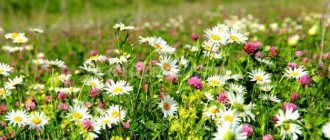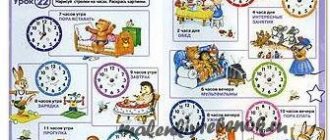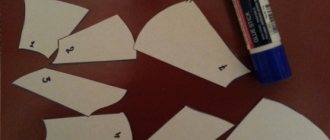Notes on cognitive development on the topic Furniture (senior group)
Abstract of educational activities on cognitive development with elements of research activities in the senior group on the topic: “Furniture”
Target:
activating children's knowledge about furniture; the material from which it is made.
Educational objectives:
activate nominative, predicative, attributive vocabulary on the topic “Furniture”. Learn to form and correctly use relative adjectives in speech, practice the formation of the plural form of the nominative case and the genitive case of nouns.
Developmental tasks:
develop the ability to compare, identify characteristics of objects, establish cause-and-effect relationships between objects and materials, generalize and draw conclusions. Develop mental operations of generalization and classification.
Educational tasks:
to develop skills of cooperation, a positive attitude towards participation in joint activities, initiative and independence. Cultivate a caring attitude towards household items
Equipment:
— Cards for the game “Fourth Odd.”
— Illustration “ancient people”.
— For educational and research activities: stones, boards, nails, hammer.
— Scheme: Stone - saw - nail with hammer - plane (all actions are crossed out). Wood - saw - nail with hammer - plane.
— Cut-out pictures (furniture).
— Scheme: one – many – none.
GCD move:
Organizing time.
Hello, golden sun! (Show the sun).
Hello, blue sky!
(Show the sky).
Hello, light breeze!
(Show “breeze”).
Hello, little oak tree!
(Show “oak tree”).
Hello, high chair! (Point to the chair).
Hello, table! (Point to the table).
Hello, guest, you have come to us! (Waving to guests).
Hello, Morning!
(Gesture to the right).
Hello Day!
( Gesture to the left
).
We are not too lazy to say hello!” ( Spread both arms to the sides
).
Main part.
By the time the guests arrived, we had put the family in order, but some items were out of place.
Exercise “4th extra”:
- Look carefully and name the extra object.
- slippers, sneakers, chair, shoes.
- cap, bed, hat, scarf.
- dress, T-shirt, wardrobe, trousers.
- jacket, overalls, coat, chair.
(Put the image of the extra item on the board).
— How can you call all these objects in one word? (Furniture)
Teacher's story, illustration:
— A long time ago, when there were no villages or cities, people lived in caves. To escape the rain and cold, they lit fires and warmed themselves by the fire.
What do you think people used to relax on? (On the grass, on the ground, on the stones).
- Think about whether it was convenient for them or not. Why was it uncomfortable? How did they feel? (Hard, uncomfortable).
The ancient people were uncomfortable, the earth was wet, cold, hard, the stones were sharp.
- If you lie in the cold for a long time, what happens? (You can freeze, catch a cold, get sick).
And then one day, the hunters, returning with their prey, sat down to rest on a fallen tree. Imagine that you are in the forest, sitting on a tree. Comfortable? Better than on earth?
It was then that the man began to think, what should he make furniture from? There were only rocks and trees around the cave.
- Let's examine and compare stones and wood (touch it, put it on your cheek, smell it).
Research activities.
- Touch the stone, tell us about it (hard, cold, heavy, uneven, rough, strong).
—
Touch the wood, tell us about it (
it’s pleasant to the touch, warm, strong, you can plan it and it will become smooth, you can drive a nail into it well, you can drill holes in it).
— Tell me, can a stone be cut? (No)
—Can you hammer a nail into a stone? (No)
—Can the stone be cut? (No)
— Let’s denote all these actions with the following diagram. (Show diagram)
—Can the tree be cut?
—Can you hammer a nail into a tree?
—Can the tree be cut?
— Let’s denote actions with a tree as follows. (Show diagram)
— Look at the diagrams and tell me, what is easier to make furniture from? Why?
Conclusion
: A person chose wood to make furniture because it is pleasant to the touch and can be processed well.
Later, furniture began to be made from other materials.
Exercise “What is furniture made of?” (in a circle)
wooden furniture – what kind? (wooden)
made of metal - which one? (metal)
made of plastic - which one? (plastic)
made of glass - which one? (glass)
We remembered what furniture is made of, and now we’ll build it ourselves.
Finger game "Furniture"
This is a chair - they sit on it ( the left palm in a fist is pressed against the right, fingers extended upward
).
This is a table - people sit at it ( the left hand is in a fist, the right open palm lies on top
)
Here is a bed - they are lying on it ( arms bent at the elbows in front of the chest, lying one on top of the other
)
We put things away in the closet ( imitation of folding things
)
We all go for a walk ( the fingers of both hands walk on the knees
)
In order for furniture to last longer, you need to take care of the furniture.
.
- How should this be done? (Wipe, wash, clean, repair, vacuum, knock out).
Cut pictures
(of four parts). Exercise “Name the parts of an object.”
Collect furniture items.
- What happened? (I got a chair, a wardrobe, an armchair)
- Name the parts of a chair, cabinet, armchair.
Game "One, many, no."
Talk about your subject using a diagram. (One - many - no).
Reflection.
— What do you remember most?
— What furniture would you choose for your apartment? Why?
— What did you especially like?
Exercise 1.Parents are recommended:
- consider with your child home furniture intended for the bedroom, dining room, kitchen;
- name the furniture and its individual parts (lid, leg, handle, armrest, back, door), external features (color, shape), material from which it is made;
- Explain to the child the purpose of furniture and its various types;
- look at the illustrations for various furniture: different types of tables (round, square, oval; desk; kitchen, dining, coffee table), cabinets (book, wardrobe, china cabinet), large and small chairs, stools; consider the furniture in the doll corner; ask the child to answer the questions: what is the furniture for (chair, table, sofa, bed, wardrobe); what is a desk or dining table for? what they do at the table; what furniture is needed for the kitchen, bedroom; how many legs does the table have? what is the table made of? what shape is the table cover; what is the difference between a chair and a stool, armchair;
- Go on an excursion to a furniture store with your child.
Task 2.
Guess the riddle and learn by choice.
Our apartment is a new house. The dishes live in the house.
There is also a place for sweets, it is called... (buffet).
With legs and no arms, with a seat and no belly, With a back and no head. (Chair)
At night, in his sleep, Vanyatka will doze off so sweetly,
Why I don’t want to get up, what kind of thing am I? (Bed)
There are four legs under the roof, soup and spoons on the roof. (Table)
Task 3.
Didactic game “Pick up a sign”: chair (which one?) - ..., armchair (which one?) - ..., bed (which one?) - ....
Task 4.
Logic exercises.
Masha is sitting on a chair. Masha will eat. Where should the chair be placed?
Olya is small. She has a small table. She sat down on a large chair. Olya has a hard time sitting, it’s uncomfortable. Why?
Task 5.
Perform actions with objects as directed by an adult (understanding prepositional constructions).
Place the ball: on a chair, under a chair, behind a chair, near a chair, Between chairs, in front of a chair; lift the ball over the chair.
Task 6.
Exercise for fingers.
Fold the “chair” out of your hands and show it to the kids.
| Raise your left hand vertically up. Press straight fingers tightly against each other. Press your right hand in a fist position to your left palm with your thumb towards you. |
Task 7.
Remember what furniture you have in your home (in the doll's corner, in the kindergarten).
Task 8.
Construct toy furniture from matchboxes.
Task 9.
Cut out pictures of various furniture and paste them into an album.
Topic: “Furniture. Furniture parts." Week from to Senior group. Teacher Korotkova O.V. Monday
Transcript
1 Topic: “Furniture. Furniture parts." Week from to Senior group Teacher Korotkova O.V. Monday Cognition (familiarization with the world around you). “Furniture in our house” Goal: To expand and systematize children’s ideas about furniture and their purpose. Learn to distinguish and name furniture parts. Fix the general concept of “furniture”. Visual activity “My Room” Purpose: to learn to compare objects of different sizes and shapes, arrange them on a sheet of paper, and use various techniques for depicting various complex objects.
2 Physical education Purpose: to exercise children in walking and running in a circle, turning in the other direction; learn to jump from foot to foot moving forward; practice crawling on all fours between pins, tossing and catching a ball. Outdoor game. “Don’t stay on the floor” Goal: develop the ability to act on a signal, restrain yourself, and perform movements expressively. Didactic game “What does it look like” Purpose: consolidation of knowledge of geometric shapes, development of observation and attention. Role-playing game “Furniture Store” Goal: to promote the development of a new plot, develop the ability to choose a role, develop the ability to fulfill a role to the end, cultivate partnerships, and develop sociocultural competencies. Recommendations for parents: Cultivate a caring attitude towards things made by human hands, an understanding of the importance of work that benefits people. Fix the name of furniture items and parts of furniture. Tuesday Cognition (FEMP) “Furniture salon” Goal: developing the ability to establish a correspondence between the number of objects and the number. Learn to compare the outline of numbers, establish their similarities and differences.
3 Outdoor game. “Pathfinders” Goal: improving coordination of movements, developing motor skills. Didactic game “What is needed for what?” Goal: develop curiosity and attention; fix the names of pieces of furniture and their functional purpose. Role-playing game “Let's arrange a room for the doll” Goal: to promote the development of a new plot, develop the ability to choose a role, develop the ability to fulfill a role to the end, and cultivate partnerships. Recommendations for parents: teach children to count to 10, reinforce the concept of quantity, teach them to find objects of different shapes, develop ideas about how to make another from one shape. Environment Application “Furniture in my house” Purpose: to teach how to create a simple composition, select the color of images, and complement the composition with characteristic details. Strengthen the ability to arrange images of furniture in different ways in the space of a sheet of paper. Practice neat cutting and pasting.
4 Physical education (outdoors) Goal: repeat walking and running between snow buildings; practice throwing snowballs at a target; repeat the game “Frost-Red Nose” Outdoor game. “Hunters and Hares” Goal: to develop motor skills, speed and attention. Didactic game “Listen, repeat, don’t change the words” Goal: to develop phonemic hearing, short-term auditory memory.. Role-playing game “Housewarming” Goal: to expand the understanding of furniture and its purpose, to promote the development of a new plot, to develop the ability to choose a role, to form the ability to fulfill a role to the end, cultivate partnerships Recommendations for parents: strengthen children’s skills in creating images from paper (cut paper into strips, cut out circles, transform one geometric shape into another. Thursday
5 Development of speech “In the cabinetmaker’s workshop.” Goal: to develop the ability to compose short descriptive stories according to the plan proposed by the teacher. Learn to form possessive adjectives (pine, oak, etc.) Develop auditory and visual memory. Physical education Purpose: to train children to walk and run between objects without touching them; continue to form stable balance when walking and running on an inclined board; practice jumping from foot to foot, throwing the ball into the hoop, developing dexterity and eye. Outdoor game. “Bears and Bees” Goal: to develop motor skills, speed and attention. Didactic game "Guess"
6 Purpose: to clarify the names of objects and their purposes, to learn to compare individual pieces of furniture, to describe them. Role-playing game “A Doll’s House” Goal: to promote the development of a new plot, develop the ability to choose a role, and develop the ability to fulfill a role to the end. Recommendations for parents: develop the child’s speech as a means of communication. Train children in the ability to combine a noun with an adjective, change words using a diminutive suffix. Friday Handmade “Furniture Workshop”. (making furniture from waste material) Goal: to develop fine motor skills, to form constructive activities when creating furniture from waste material, to introduce children to work. Reading fiction. S.Ya. Marshak “Where did the table come from?” Goal: to teach children to perceive short literary works; explain unclear words; pose questions to the text, answer the questions posed.
7 Outdoor game. “As you drive more quietly, you will continue” Goal: to develop motor skills, develop speed, agility, and the ability to listen to commands. Didactic game “Name the parts that make up the furniture” Purpose: to consolidate children’s ideas on the topic, to activate the vocabulary. Role-playing game “Furniture Salon” Purpose: To develop attention, promote the development of a new plot, develop the ability to choose a role, develop the ability to fulfill a role to the end. Recommendations for parents: develop the child’s interest in visual arts. Enrich their sensory experience by developing their senses of perception: vision, hearing, smell, touch, taste; consolidate knowledge about the basic forms of objects and natural objects.






